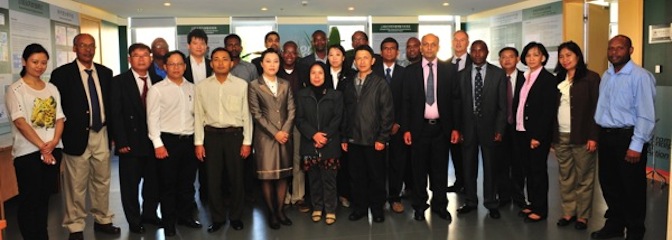Effective response to reduce the risk of disasters resulting from hydromet hazards depends on close cooperation between emergency operations, disaster prevention and management specialists, and national meteorological and hydrological services. GFDRR has actively supported efforts to strengthen all of the elements in the information chain. In 2013, GFDRR organized workshops for teams from client countries, comprising representatives from national emergency management agencies and from national hydromet services, to share insights into their systems. The workshops were held at the China Meteorological Administration’s Shanghai Meteorological Service, which has pioneered multi-hazard early warning systems and has been designated by the Shanghai Municipal Government as the provider of early warnings for all hazards within Shanghai.
China
Users of weather information are of many kinds: from the general public to government ministries, the military and private industry. Weather services should provide services to and receive support and feedback from government departments such as Agriculture, Fisheries, Flood Control, Traffic and Transportation, Fire Control, Police, Environmental Protection, Civil Administration, Public Health, Tourism, Harbor and Maritime Management.

Workshop participants.
Severe weather often has a domino effect. For example, typhoons result in heavy rains causing inundation, flooding residential areas and farmland; at the same time, flooded roads disrupt livelihoods and can cause traffic accidents.
The Shanghai Emergency Warning Center has the responsibility of disseminating warnings for all hazards across Shanghai. Staff members of the Center seek to extract lessons from experience. For example, the Center warned over 18 million people of Tropical Cyclone Fitow on October 6, 2013. But could the warnings have prevented even more damage if people had been alerted earlier, even though a practice of issuing earlier forecasts would be accompanied by greater uncertainty? What if earlier warnings were provided but were color-coded to signal the lower certainty? Reflecting on such questions, the Center strives to raise the value of its warning services for the people of Shanghai.
Indonesia
Indonesia is subject to a range of natural hazards including many driven by weather events: flooding, water spouts, landslides, drought, wave abrasion and fires. Indonesia’s primary concern is the high risk of earthquake and tsunami. Since the Indian Ocean tsunami of 26 December 2004, which killed 165,708 Indonesians, subsequent earthquakes and tsunamis have killed a further 31,444 people in Java and Sumatra with most deaths resulting from tsunamis.
An earthquake that struck Aceh in April 2012 identified a number of ongoing weaknesses in the system. Buildings designed to shelter people from tsunamis were not used as planned; instead, people fled to hills, causing major congestion on the roads and compounding the difficulty of evacuating those with no access to local shelters. More than 70% of evacuees attempted to use cars to escape. Communication broke down. More than 60% of people did not hear sirens. Electricity was cut off, delaying SMS and fax messages. Information from the Meteorology, Climatology and Geophysical Agency which should take 5 minutes to reach disaster prevention officers took 30 minutes. The authority and responsibility to command early warning alarms, evacuation orders and standard operating procedures at various levels of government was unclear.
The Indonesian Government has now developed a disaster prevention/mitigation master plan which is comprised of four programs: enhancement of the early warning chain with greater integration among ministries and between central and local government; development of shelters and evacuation routes; enhancement of preparedness and disaster risk reduction at the community level; and the development of disaster instrumentation technology within Indonesia.
